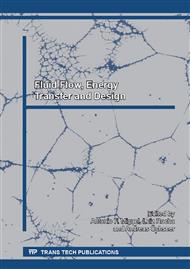[1]
D. Anfossi, G. Bonino, F. Bossa, R. Richiardone, Plume rise from multiple sources: a new model, Atmospheric Environment 12 (1978) 1821-1826.
DOI: 10.1016/0004-6981(78)90001-x
Google Scholar
[2]
G. Gangoiti, J. Sancho, G. Ibarra, L. Alonso, J.A. Garcïa, M. Navazo, N. Durana, J.L. Ilardia, Rise of moist plumes from tall stacks in turbulent and stratified atmospheres, Atmospheric Environment 31 (1997) 253-269.
DOI: 10.1016/1352-2310(96)00165-3
Google Scholar
[3]
G. A. Briggs, Plume rise from multiple sources, Proceedings of cooling tower environment held at University of Maryland (1974) 161-179.
Google Scholar
[4]
G. A. Briggs, Plume Rise Predictions. Lectures on Air Pollution and Environmental Impact Analyses. American Meterological Society (1975) 59–111.
DOI: 10.1007/978-1-935704-23-2_3
Google Scholar
[5]
T. L. Montgomery, W.B. Norris, F.W. Thomas, S.B. Carpenter, A simplified technique used to evaluate atmospheric dispersion of emissions from large plants, J. Air. Poll. Control Ass. 23 (1973) 388-457.
DOI: 10.1080/00022470.1973.10469784
Google Scholar
[6]
A. Radhouane, N. Mahjoub Saïd, H. Mhiri, G. Le Palec, P. Bournot, Impact of the initial streamwise inclination of a double jet emitted within a cool crossflow on its temperature field and pollutants dispersion, Heat and Mass Transfer 45 (2009).
DOI: 10.1007/s00231-008-0473-6
Google Scholar
[7]
A. Radhouane, N. Mahjoub Saïd, H. Mhiri, G. Le Palec, P. Bournot, Dispersion of Twin Inclined Fume Jets of a variable height Within a Crossflow, Defect and Diffusion Forum 312-315 (2011) 929-934.
DOI: 10.4028/www.scientific.net/ddf.312-315.929
Google Scholar
[8]
A. Radhouane, I. Bhouri Baouab, N. Mahjoub Said, H. Mhiri, Ph. Bournot, G. Le Palec, Temperature impact on the turbulence generated by the interaction of twin inline inclined jets in crossflow, Heat and Mass Transfer Journal 45 (2013) 1597-1616.
DOI: 10.1007/s00231-012-1108-5
Google Scholar
[9]
K. Bunsirisert, C. Orrala, H.R. Rahai, Profiles of two elevated side-by-side turbulent jets in a crossflow, 43rd AIAA Aerospace Sciences Meeting and Exhibit, Reno, Nevada (2005).
DOI: 10.2514/6.2005-1062
Google Scholar
[10]
R. W. Macdonald, R.K. Strom, P.R. Slawson, Water flume study of the enhancement of buoyant rise in pairs of merging plumes, Atmospheric Environment 36 (2002) 4603–4615.
DOI: 10.1016/s1352-2310(02)00464-8
Google Scholar
[11]
D. J. Moore, A comparison of the trajectories of rising buoyant plumes with theoretical/empirical models, Atmospheric environment 8 (1974) 441-457.
DOI: 10.1016/0004-6981(74)90060-2
Google Scholar
[12]
D. D. J. Netterville, Plume rise, entrainment and dispersion in turbulent winds, Atmospheric Environment 24A (1990) 1061-1081.
DOI: 10.1016/0960-1686(90)90074-w
Google Scholar
[13]
P. Goyal, T.V.B.P.S. Rama Krishna, Dispersion of pollutants in convective low wind: a case study of Delhi, Atmospheric Environment 36 (2002) 2071–(2079).
DOI: 10.1016/s1352-2310(01)00458-7
Google Scholar
[14]
M. Koklu, O. Baysal, Modelling, parameterisation and simulation-based optimisation of a microflow-control actuator, International Journal of Computational Fluid Dynamics 22 (2008) 367–381.
DOI: 10.1080/10618560802119665
Google Scholar
[15]
S.H. Smith, M.G. Mungal, Mixing structure and scaling of the jet in crossflow, J. Fluid Mech. 357 (1998) 83-122.
DOI: 10.1017/s0022112097007891
Google Scholar


